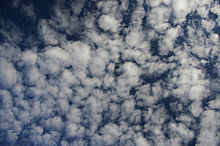

| Altocumulus clouds | |
|---|---|

Altocumulus cloud formation
| |
| Abbreviation | Ac |
| Symbol | |
| Genus | alto-, meaning high, and cumulo-, meaning heap |
| Species |
|
| Variety |
|
| Altitude | 2,000–7,000 m (7,000–23,000 ft) |
| Classification | Family B (Medium-level) |
| Appearance | Middle-altitude Stratocumulus clouds arranged in groups or rolls. Has smaller clouds separate from each other |
| Precipitation | Virga only |
Altocumulus (from Latin altus 'high', and cumulus 'heaped')[1] is a middle-altitude cloud genus that belongs mainly to the stratocumuliform physical category, characterized by globular masses or rolls in layers or patches – the individual elements being larger and darker than those of cirrocumulus and smaller than those of stratocumulus.[2] However, if the layers become tufted in appearance due to increased airmass instability, then the altocumulus clouds become more purely cumuliform in structure. Like other cumuliform and stratocumuliform clouds, altocumulus signifies convection. A sheet of partially conjoined altocumulus perlucidus is sometimes found preceding a weakening warm front, where the altostratus is starting to fragment, resulting in patches of altocumulus perlucidus between the areas of altostratus. Altocumulus is also commonly found between the warm and cold fronts in a depression, although this is often hidden by lower clouds.
Towering altocumulus, known as altocumulus castellanus, frequently signals the development of thunderstorms later in the day, as it shows instability and convection in the middle levels of the troposphere, the area where towering cumulus clouds can turn into cumulonimbus.[3] It is therefore one of three warning clouds often recorded by the aviation industry, the other two being towering cumulus and cumulonimbus.[3] Altocumulus generally forms at about 2,000 to 6,100 m (6,600 to 20,000 ft) above ground level, a similar level to altostratus formations, and satellite photography has revealed that the two types of cloud can create formations that can stretch for thousands of square miles.[4] Extensive altocumulus formations, particularly if they take the form of undulatus are often referred to as altocumulus mackerel sky.

|
Cloud genera and selected species, supplementary features, and other airborne hydrometeors - WMO Latin terminology except where indicated
| |||||||||||||||||||||||||||||||||||||||||||||||||||||||||||||||||||||
|---|---|---|---|---|---|---|---|---|---|---|---|---|---|---|---|---|---|---|---|---|---|---|---|---|---|---|---|---|---|---|---|---|---|---|---|---|---|---|---|---|---|---|---|---|---|---|---|---|---|---|---|---|---|---|---|---|---|---|---|---|---|---|---|---|---|---|---|---|---|
| Mesospheric |
| ||||||||||||||||||||||||||||||||||||||||||||||||||||||||||||||||||||
| Stratospheric |
| ||||||||||||||||||||||||||||||||||||||||||||||||||||||||||||||||||||
| Tropospheric |
| ||||||||||||||||||||||||||||||||||||||||||||||||||||||||||||||||||||